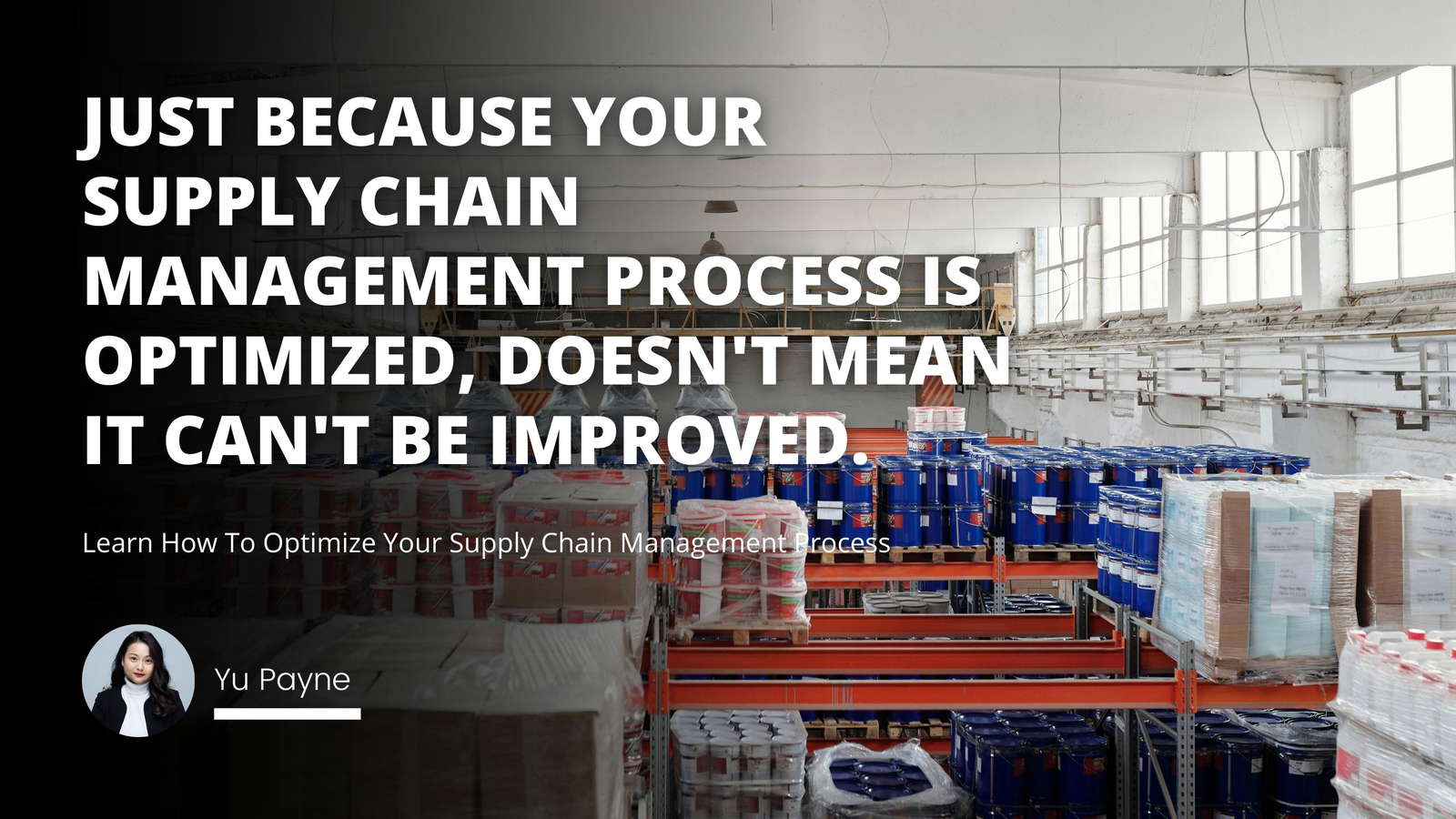
Preventing Unplanned Shutdowns Through Effective Inventory Management
There was a time early in my career when I worked for a small manufacturing company. One crisp Monday morning, the entire production line ground to a halt. Workers stood around, machines were silent, and there was a palpable sense of frustration in the air. The culprit? A tiny, seemingly insignificant component was out of stock. That day, I learned firsthand how a simple oversight in inventory management could cascade into a significant operational crisis.
Understanding the Ripple Effect of Inventory Shortages
Unplanned shutdowns in production aren't just inconvenient—they can be catastrophic. They can disrupt the entire supply chain management process, leading to delayed orders, unhappy customers, and a tarnished reputation. But what exactly causes these sudden halts?
Introduction
Causes of Unplanned Shutdown
Preventing Unplanned Shutdown
Benefits of Inventory
Conclusion
While factors like power outages, equipment failure, or unexpected strikes can play a role, a lack of inventory remains the most common and preventable cause. Imagine a bakery running out of flour or a car manufacturer missing a crucial bolt. Without these essential materials, operations come to a standstill.
The Heartbeat of Production: Inventory Management
At its core, inventory management is about ensuring that the right quantity of the right item is available at the right time. It's the backbone of an efficient production system. By optimizing your inventory, you can:
Reduce operational costs by avoiding overstocking.
Improve customer satisfaction with timely deliveries.
Enhance production efficiency by preventing delays.
Why Proper Inventory Management Matters
Consider this: Holding too much stock ties up capital and increases storage costs. On the flip side, insufficient inventory can halt production and damage customer relationships. Striking the right balance is crucial.
Strategies to Prevent Unplanned Shutdowns
So, how can businesses shield themselves from the pitfalls of inventory shortages? Here are some tried-and-true strategies:
Balancing Inventory & Customer Service: Supply Chain Management
Introducing the SCOR Model: Unlocking Supply Chain Management
1- Implement Just-In-Time (JIT) Inventory Systems
Just-In-Time inventory systems aim to reduce waste by receiving goods only as they are needed. This approach minimizes inventory costs and reduces the risk of obsolescence.
2- Leverage Technology for Inventory Tracking
Modern inventory management software can provide real-time insights into stock levels. Tools like RFID tags and barcoding streamline tracking, ensuring accuracy and efficiency.
3- Establish Strong Supplier Relationships
Maintaining open communication with suppliers can help anticipate delays and adjust orders accordingly. A reliable supplier network is essential for a resilient supply chain mgmt.
4- Conduct Regular Inventory Audits
Periodic checks can identify discrepancies early on. Audits help in:
Verifying stock levels.
Identifying slow-moving items.
Detecting potential theft or loss.
5- Adopt Demand Forecasting Techniques
By analyzing historical sales data and market trends, businesses can predict future inventory needs. Accurate forecasting reduces the risk of both overstocking and stockouts.
Real-Life Example: The Cost of Poor Inventory Management
A well-known electronics manufacturer once faced a massive production halt because a specific microchip was unavailable. The reason? A sudden spike in demand wasn't anticipated, and their inventory system failed to flag the diminishing stock levels. This oversight not only led to significant financial losses but also allowed competitors to capture a portion of their market share.
The Broader Benefits of Effective Inventory Management
Beyond preventing shutdowns, efficient inventory practices offer a plethora of advantages:
Improved Cash Flow: Less money is tied up in unsold stock.
Enhanced Supplier Negotiations: Better purchasing power with clear insights into buying patterns.
Increased Operational Flexibility: Ability to adapt quickly to market changes.
Tips to Optimize Your Supply Chain Management Process
Enhancing your supply chain management isn't just about inventory. It's about creating a cohesive, end-to-end process that maximizes efficiency. Here are some tips:
Integrate Supply Chain with Business Strategy: Align your SCM management goals with overall business objectives.
An ounce of inventory is worth a pound of supply chain downtime.
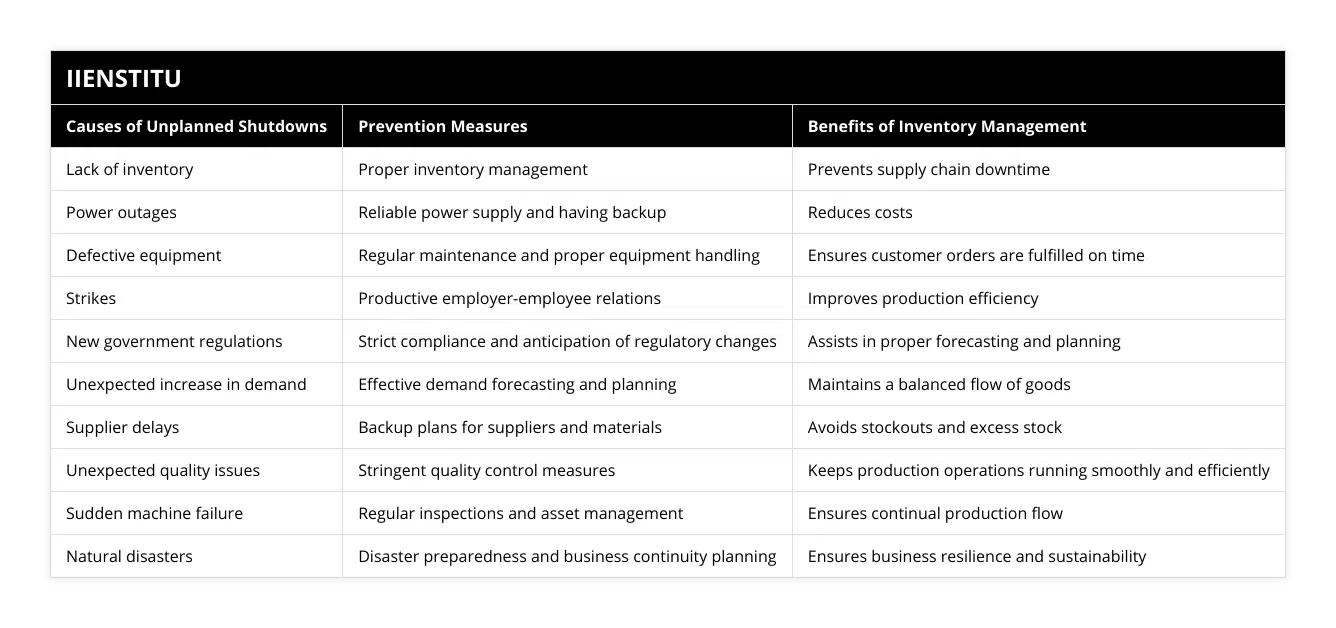
Invest in Employee Training: Well-trained staff can identify potential issues before they escalate.
Utilize Data Analytics: Harness the power of data to uncover insights and drive decision-making.
Strengthen Communication Channels: Ensure seamless information flow between all stakeholders.
Embracing Technology in Supply Chain Management
In today's digital age, technology plays a pivotal role in SCM chain management. Tools like Artificial Intelligence (AI) and the Internet of Things (IoT) are transforming how businesses operate:
AI and Machine Learning: Aid in accurate demand forecasting and trend analysis.
IoT Devices: Provide real-time tracking of goods, enhancing transparency.
Blockchain Technology: Offers secure and transparent transaction records.
Personal Reflections on Supply Chain Challenges
Looking back, one of the most challenging periods in my career was managing supply during a global shortage of raw materials. It was a lesson in adaptability and the importance of proactive planning. We had to think outside the box, sourcing alternative materials and re-negotiating with suppliers. This experience reinforced the notion that flexibility and foresight are invaluable in supply and chain management.
Building a Resilient Supply Chain
Resilience is about more than just bouncing back—it's about anticipating challenges and preparing for them. Here are steps to build a robust supply chain:
1- Diversify Your Supplier Base
Relying on a single supplier can be risky. Diversification mitigates this risk and ensures a steady flow of materials.
2- Implement Risk Management Strategies
Identify potential risks in your chain of supply management and develop contingency plans.
3- Enhance Visibility Across the Supply Chain
Utilize integrated systems to get a holistic view of operations, enabling quicker responses to issues.
The Human Element in Supply Chain Management
At the end of the day, people are at the heart of supply chain operations. Encouraging collaboration, fostering a culture of continuous improvement, and valuing employee feedback can lead to significant enhancements in management chain supply.
Conclusion: Turning Challenges into Opportunities
Unplanned shutdowns can be daunting, but they also present an opportunity to re-evaluate and strengthen your operations. By focusing on effective inventory management and robust SCM supply chain management practices, businesses can not only prevent disruptions but also position themselves for long-term success.
Remember, an ounce of inventory is worth a pound of supply chain downtime. Investing time and resources into proper inventory practices today can save immeasurable headaches tomorrow.
References
1- Stevenson, W. J. (2018). Operations Management (13th ed.). McGraw-Hill Education.
2- Krajewski, L. J., Ritzman, L. P., & Malhotra, M. K. (2019). Operations Management: Processes and Supply Chains (12th ed.). Pearson.
3- Simchi-Levi, D., Kaminsky, P., & Simchi-Levi, E. (2020). Designing and Managing the Supply Chain: Concepts, Strategies, and Case Studies (4th ed.). McGraw-Hill Education.
4- Heizer, J., Render, B., & Munson, C. (2020). Principles of Operations Management: Sustainability and Supply Chain Management (11th ed.). Pearson.
5- Chang, Y. (2017). Supply Chain Management in the Big Data Era. IGI Global.
Key Takeaways
Effective inventory management is crucial to prevent unplanned shutdowns.
Understanding and anticipating potential risks can save time and resources.
Investing in technology enhances transparency and efficiency in the supply chain.
People and relationships matter. Strong supplier and team relationships can make all the difference.
Stay adaptable and proactive to turn challenges into growth opportunities.
Optimizing your supply chain management process doesn't happen overnight. But with the right strategies and a commitment to continuous improvement, you can build a resilient, efficient, and responsive operation.
Let’s embark on this journey together and transform challenges into stepping stones for success in the world of supply chain management!
Frequently Asked Questions
What are the primary causes of unplanned shutdowns in the supply chain?
Unplanned shutdowns in the supply chain can have various causes, but some primary reasons are this article will explore these primary causes and discuss the potential solutions.
The first primary cause of unplanned shutdowns in the supply chain is inadequate planning. Poor planning can lead to delays in production, delivery, or other elements of the supply chain. This can result in costly shutdowns, as well as disruptions in customer service. To address this issue, companies should ensure a comprehensive plan with contingencies for any unexpected delays or issues. Additionally, it is essential to have an effective communication strategy between all stakeholders in the supply chain to ensure that everyone is aware of any changes or issues that may arise.
The second primary cause of unplanned shutdowns in the supply chain is an inability to anticipate demand. If a company cannot accurately forecast the market, it is more likely to experience disruptions in the supply chain. To address this issue, companies should invest in predictive analytics and other forecasting tools to ensure that they can accurately anticipate customer demand. Companies should also ensure they have the capacity to meet the expected demand.
The third primary cause of unplanned shutdowns in the supply chain is inadequate inventory management. If a company does not have an effective inventory management system, it will be more likely to experience unplanned shutdowns. To address this issue, companies should invest in an effective inventory management system that can alert them to any shortages or surpluses in inventory. Companies should also consider outsourcing their inventory management to a third-party vendor to ensure they have the necessary resources to manage their inventory effectively.
Finally, the fourth primary cause of unplanned shutdowns in the supply chain is a lack of visibility. If a company does not have the necessary visibility into its supply chain, it will be more likely to experience unplanned shutdowns. To address this issue, companies should invest in technologies such as RFID and IoT sensors to provide visibility into their supply chain. In addition, companies should also consider investing in supply chain analytics platforms to help them gain better insights into their supply chain.
In conclusion, there are a variety of primary causes of unplanned shutdowns in the supply chain. However, with adequate planning, forecasting, inventory management, and visibility, companies can reduce the likelihood of experiencing unexpected shutdowns in their supply chain.
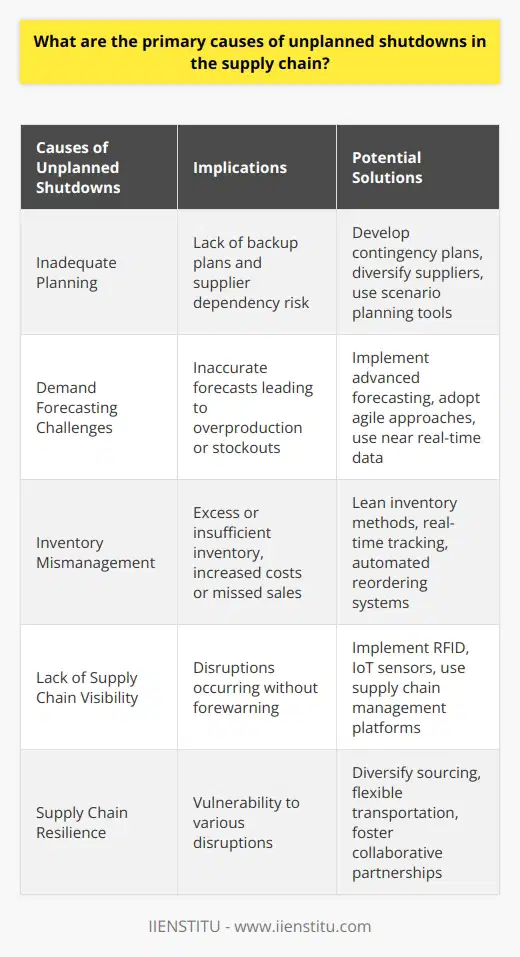
How can inventory be used to prevent unplanned shutdowns?
Unplanned shutdowns can be costly, disruptive, and time-consuming. As such, companies need to have strategies in place to prevent them. One such strategy is the use of inventory. Inventory management can be used to provide a buffer of spare parts and materials that can be used to repair problems and prevent unplanned shutdowns quickly.
Consider effective inventory management involves the appropriate use of forecasting, purchasing, and stocking processes. Forecasting predicts the number of materials or parts that will be needed shortly. This process should take into account the expected usage rate, lead times, and any potential disruptions in the supply chain. Purchasing involves ensuring that the necessary materials and parts are available when needed. Finally, stocking ensures that the materials and components are stored in the correct location and in good condition.
Inventory management also involves understanding the materials and parts required for each type of machinery and the expected lifetime of these materials and components. By understanding the expected lifetime of the materials and components, companies can ensure sufficient buffer stocks to prevent unplanned shutdowns. Furthermore, companies should also have strategies in place to monitor the condition of the materials and parts. This can help identify potential problems before they lead to unplanned shutdowns.
Finally, the use of inventory should be combined with proactive maintenance and testing. Proactive maintenance involves regularly testing and inspecting machinery and parts to identify potential problems. This can help to prevent unplanned shutdowns due to worn or damaged machinery and components.
Inventory management can be an effective strategy for preventing unplanned shutdowns. By forecasting, purchasing, and stocking the necessary materials and parts, companies can ensure that they have a buffer of spare parts and materials that can quickly repair problems and prevent unplanned shutdowns. Additionally, understanding the expected lifetime of the materials and components and proactively monitoring their condition can help to identify any potential issues before they lead to unplanned shutdowns. Ultimately, using inventory management in combination with proactive maintenance can help to ensure that companies can prevent unexpected shutdowns.
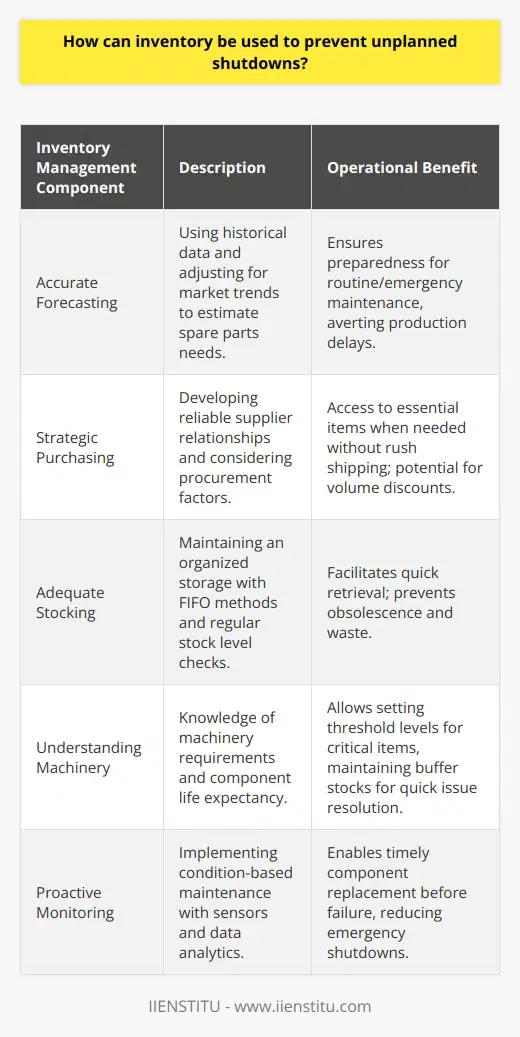
What are the benefits of having an adequate inventory level?
Having an adequate inventory level can be beneficial to businesses in a variety of ways. A good inventory level is when the amount of stock is neither too high nor too low and can be used to meet customers' demands. This article will discuss the advantages of having an adequate inventory level.
One of the main benefits of having an adequate inventory level is that it can help businesses reduce inventory costs. Inventory costs include the cost of storing and maintaining stock and the cost associated with ordering and restocking. By keeping an adequate inventory level, businesses can reduce the amount of stock they need to purchase and store, resulting in lower inventory costs.
Another benefit of having an adequate inventory level is that it can help businesses maintain customer satisfaction. Customers are more likely to be satisfied when their orders are fulfilled promptly and with the correct product. Conversely, if companies do not maintain an adequate inventory level, there is a risk that customers may not be able to receive their orders on time or with the correct product.
Proportionally, having an adequate inventory level can help businesses maximize their profits. When companies cancan maintains a good inventory level, they can ensure they can meet customer demand while minimizing the amount of stock they need to purchase and store. This can help businesses increase their profits by reducing inventory costs and increasing customer satisfaction.
Overall, having an adequate inventory level can be beneficial to businesses in a variety of ways. By maintaining a proper inventory level, companies can reduce their inventory costs, maximize customer satisfaction, and maximize their profits. Therefore, businesses need to strive to maintain an adequate inventory level.

What measures of inventory are important to supply chain management?
Significance of Inventory Measures
Inventory measures play a critical role in supply chain management as they help organizations maintain optimal stock levels, minimize costs, and enhance customer satisfaction. Several essential measures are applicable for managing inventory within the supply chain context.
Turnover Rate
The inventory turnover rate is a crucial metric that demonstrates how frequently inventory is sold and replaced within a specific time frame. It determines the efficiency of supply chain operations by revealing the number of times a company cycles through its inventory within a given period. High turnover rates indicate that products are being sold quickly, signaling effective supply chain management.
Days of Inventory
Another essential measure is Days of Inventory (DOI), which shows the average number of days a product remains in stock before being sold. This metric helps supply chain managers predict inventory requirements, manage lead times, and optimize order sizes for better cash flow management. A lower DOI value signifies that inventory is moving through the supply chain more efficiently, thus lowering holding costs and increasing cash flow.
Stockout Rate
Stockout rate refers to the percentage of time a product is unavailable in stock when demanded by customers. In supply chain management, minimizing stockout rates is vital to maintain customer satisfaction and loyalty. Monitoring stockout rates enables companies to identify patterns and trends that may need adjustments to inventory levels, sourcing, or production processes.
Safety Stock Levels
Safety stock is the additional inventory held to mitigate the risk of stockouts in case of unpredictable changes in demand or lead times. Maintaining optimal safety stock levels is essential for supply chain resilience and customer satisfaction. Calculating and monitoring safety stock levels involve considering variables like demand variability, lead time, and service levels.
Inventory Accuracy
Lastly, inventory accuracy involves the consistency between actual physical inventory and the recorded inventory data. Accurate inventory data ensures appropriate stock levels, mitigates stockouts and overstock situations, and facilitates informed decision-making in supply chain management. Regular cycle counting and applying inventory management systems can help maintain high inventory accuracy.
In conclusion, effective supply chain management relies on various inventory measures. The inventory turnover rate, Days of Inventory, stockout rate, safety stock levels, and inventory accuracy are essential metrics to consider when managing supply chain processes. By monitoring and optimizing these measures, organizations can improve their overall supply chain performance and maintain a competitive edge.
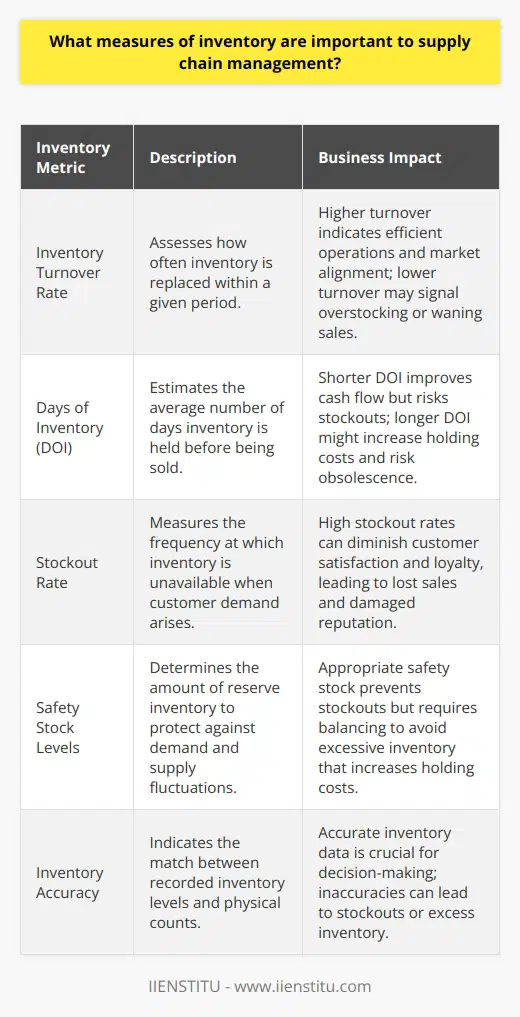
What are the 3 major inventory management techniques?
Three Major Techniques in Inventory Management
Just-in-Time Inventory Method
Just-in-time (JIT) inventory management, also known as lean inventory management, is a technique that attempts to minimize stock keeping and transportation costs, through the timely delivery of goods. The primary objective of JIT is to order and receive inventory as needed, rather than storing large quantities in a warehouse. This strategy reduces inventory holding costs and capital commitment, ultimately increasing the firm's competitiveness and profitability.
Economic Order Quantity Model
Economic order quantity (EOQ) is a formula used to determine the optimal order quantity that minimizes the total cost of inventory management. This technique considers ordering costs, carrying, or holding costs, stockout costs, or costs associated with running out of inventory. The EOQ model assumes that demand and lead times are predictable, allowing businesses to make informed decisions about the financial viability of different order quantities. EOQ is especially beneficial for small- and medium-sized businesses in determining the most cost-effective inventory management practices.
ABC Inventory Classification System
The ABC inventory classification system is an inventory management technique based on the Pareto principle or the 80/20 rule. This method categorizes inventory items into three groups, A, B, and C, based on their value, importance, and demand. Group A products typically account for a small percentage of total inventory items, but the highest value or demand. Meanwhile, Group C items are low-value, high-volume items that make up the bulk of the stock. Group B products lie at a midpoint between A and C, reflecting a moderate value and demand. This classification system enables businesses to optimize inventory management efforts and resources, prioritizing high-value items and reducing storage and handling costs associated with less valuable items.
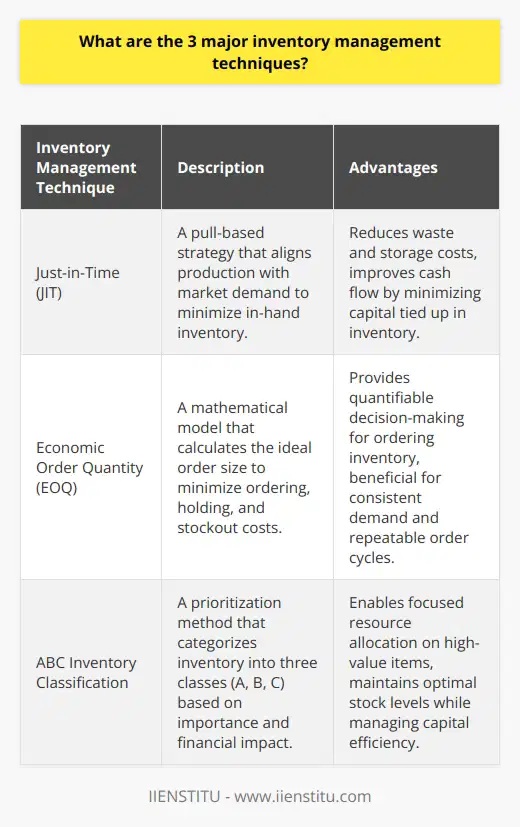
What is the key point of inventory control?
Key Point of Inventory Control
Effective Management
The key point of inventory control lies in the effective management of a company's stock, ensuring that the right products are available in the right quantities, at the right time, and in the right location. This process plays a crucial role in guaranteeing the smooth operation of a business, minimizing costs, and maximizing profits.
Balancing Supply and Demand
Inventory control aims to strike an optimal balance between supply and demand by closely monitoring and evaluating inventory levels. In doing so, management can determine the appropriate reordering levels, lead times, and safety stock quantities. This balance helps address the risk of stockouts and excess inventory, ultimately contributing to enhanced customer satisfaction.
Reducing Costs and Risks
Cost reduction is one of the primary objectives of inventory control as it directly impacts the profitability of a business. Effective inventory control techniques allow businesses to minimize holding, stock out, and ordering costs. Moreover, the implementation of inventory control systems helps minimize the risk of obsolescence, spoilage, and shrinkage, preventing potential profit loss.
Improving Cash Flow
By employing inventory control strategies, businesses can optimize their cash flow by reducing the amount of capital tied up in inventory. Freeing up cash tied in inventory allows companies to improve liquidity and allocate resources to other essential areas, such as marketing, innovation, and expansion.
Enhancing Efficiency and Productivity
Proactive inventory control practices contribute to the overall efficiency and productivity of the supply chain as they ensure that products are readily available to meet customer demand. This prevents production delays and backorders, streamlining operational processes, and resulting in better service and satisfaction levels for the company's customers.
Leveraging Technology for Visibility
The adoption of technology, such as inventory management software or ERP systems, has allowed companies to gain better visibility and control over their stock levels. This integration of technology not only automates a traditionally manual process but also provides real-time data and actionable insights, enabling management to make informed decisions regarding inventory control and overall business strategy.
In conclusion, the key point of inventory control revolves around the effective management of stock levels to create a balance between supply and demand. This balance helps reduce costs, improve cash flow, enhance efficiency and productivity, and provide better service to customers. The implementation of technology further supports these goals by providing increased visibility and data-driven insights for improved decision-making.

What is the inventory strategy of the supply chain?
Inventory Strategy in the Supply Chain
The Role of Inventory Management
In the realm of supply chain management, inventory strategy plays a pivotal role in determining the size and placement of stocked goods. An effective inventory strategy helps streamline the supply-demand balance, ensuring proper inventory levels for customer satisfaction, cost minimization, and efficient order fulfillment.
Centralized versus Decentralized Inventory
Supply chain managers have two primary inventory strategies at their disposal: centralized and decentralized inventory. A centralized inventory strategy combines stock into a single location, potentially reducing storage costs and simplifying inventory management. Conversely, a decentralized inventory strategy places inventory across multiple locations, often improving lead times and increasing responsiveness to local market variations.
Safety Stock and Anticipating Demand
In addition to selecting an inventory structure, supply chain managers must consider safety stock levels. Safety stock acts as a buffer against stockouts and leads to higher customer satisfaction by meeting demand unpredictability. Calculating the right safety stock levels requires a thorough understanding of demand forecasting and lead time variability to strike a balance between reducing stockout risks and minimizing holding costs.
Inventory Optimization Techniques
To achieve an efficient balance within the supply chain, various inventory optimization techniques exist, including Economic Order Quantity (EOQ) and Just-in-time (JIT) inventory. The EOQ model is a quantitative method used to determine the ideal order quantity for minimizing total inventory costs, considering holding and ordering costs. JIT inventory is an inventory management model that relies on exact timing, ordering only the required amount of materials or goods for imminent production or sale.
Technology's Impact on Inventory Strategy
Advances in technology have given rise to innovative inventory management tools and applications that streamline and improve supply chain operations. For instance, the use of cloud-based inventory systems provides real-time inventory tracking and data analysis, enabling better demand forecasting and efficient inventory handling. Additionally, artificial intelligence and machine learning algorithms now offer supply chain managers access to predictive analytics, enhancing the accuracy of demand forecasting and stock level optimization.
Effective inventory strategy is a crucial component of the supply chain management process. By assessing various inventory structures, calculating safety stock levels, and utilizing technological advancements, supply chains can achieve optimal efficiency and better serve their end customers.
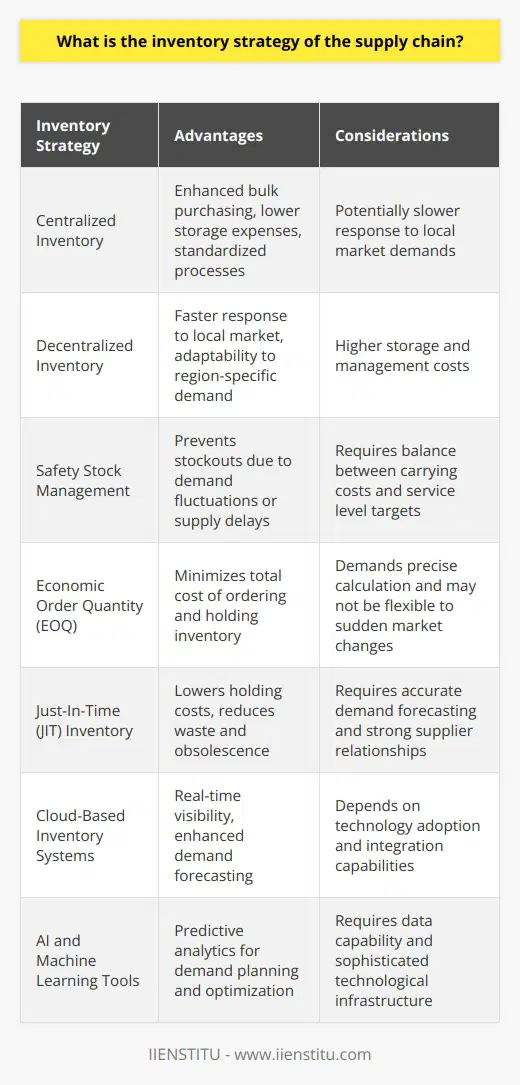
How do you control inventory in supply chain management?
Understanding Inventory Control in Supply Chain Management
Inventory control plays a vital role in supply chain management. It helps businesses manage their stocks to meet customer demands and maintain cost efficiency. To control inventory, three main factors should be monitored: inventory levels, order quantities, and lead times.
Balancing Inventory Levels
Effective inventory control involves keeping inventory levels balanced. This is achieved by maintaining enough stock to meet customer demands, while not having excess inventory. Regularly checking inventory levels and revising them based on demand and supply factors helps in optimizing stock quantities.
Implementing Reorder Point Systems
A practical way to control inventory is by using a reorder point system. An order point is a predetermined level at which stocks are replenished. Whenever stocks reach this level, new orders are placed. This approach ensures a continuous supply of products while reducing stockouts and overstock situations.
Utilizing Inventory Models
Inventory models, such as Economic Order Quantity (EOQ) model, aid in decision-making for inventory control. EOQ calculates the optimal order size to minimize inventory costs. It considers factors such as ordering and holding costs, leading to efficient inventory management.
Lead Time Management
Lead times are crucial in inventory control. They refer to the time interval between placing an order and receiving the delivery. Proactive monitoring and management of lead times help in reducing stockouts and maintaining inventory levels. Working closely with suppliers and using tools to monitor lead times can improve inventory control.
Leveraging Technology
Modern technology, such as inventory management software, provides real-time data on inventory levels, sales, and purchasing patterns. Integrating such systems with supply chain management can result in more accurate forecasts and improved inventory control. Companies can use this data to make informed decisions on stocking levels and replenishments.
In conclusion, controlling inventory in supply chain management is essential for businesses to maintain operational efficiency and meet customer demands. Implementing these strategies allows organizations to reduce costs and optimize inventory levels. Proper inventory control is thus an integral part of effective supply chain management.
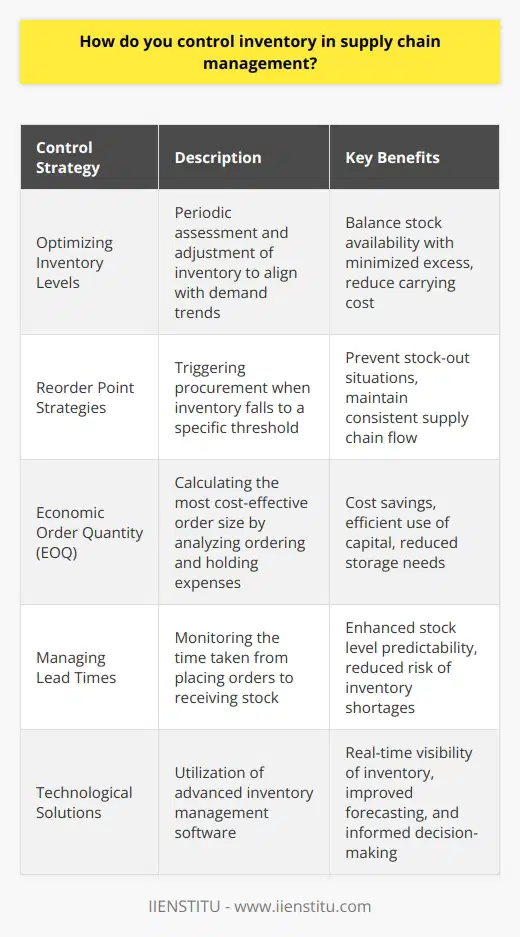
What are three ways a company can minimize loss due to supply chain problems?
**Robust Risk Management**
One way a company can minimize losses due to supply chain problems is by implementing robust risk management. This involves proactively identifying, assessing, and prioritizing potential risks, and developing contingency plans to address them. By anticipating disruptions and having multiple alternative sourcing options, companies can quickly adapt and reduce the impact of supply chain issues on their operations.
**Effective Communication and Collaboration**
Another approach to minimizing losses is by fostering effective communication and collaboration along the supply chain. This includes maintaining regular contact with suppliers, ensuring customer expectations are communicated, and staying informed about industry trends and potential disruptions. By collaborating with supply chain partners, companies can build trust, share best practices, and work together to promptly address any issues that may arise.
**Investment in Digital Transformation**
Lastly, investing in digital transformation is crucial for companies seeking to minimize losses due to supply chain problems. Incorporating technologies such as artificial intelligence, machine learning, and the Internet of Things can enhance supply chain visibility, making it easier to track and monitor inventory, analyze trends, and forecast demand. By embracing digital advancements, companies can streamline their supply chain processes, reduce costs, and maintain a competitive edge in the face of unforeseen disruptions.
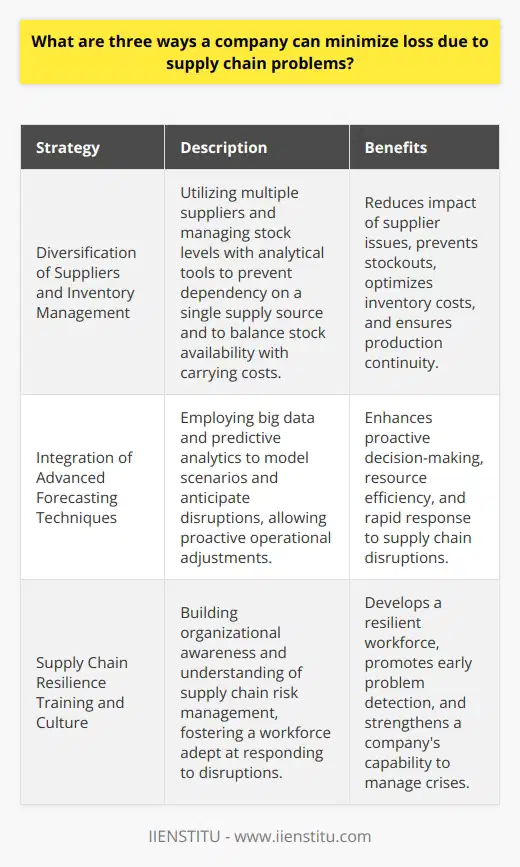
Why is inventory important in supply chain management?
Inventory Significance
The importance of inventory in supply chain management (SCM) is multifaceted.
Role of Inventory
Firstly, inventory acts as a buffer against unforeseen demand. It helps firms manage inconsistencies between supply and demand, ensuring continuity of operations.
Inventory and Assurance
Moreover, it provides assurance to customers about the availability of goods for purchase. This assurance can significantly influence consumers' purchasing decisions.
Inventory as a Cost Control Mechanism
Another purpose of managing inventory is cost control. By holding only the required amount of inventory, firms can reduce storage costs and prevent obsolescence of goods.
Influence of Inventory on Responsiveness
Inventory also impacts supply chain responsiveness. For instance, maintaining an optimal stock level enables firms to quickly respond to demand changes or disruptions in the supply chain.
Inventory and Competitive Advantage
Furthermore, efficient inventory management can foster a competitive advantage. Through accurate forecasting and efficient inventory control, companies can reduce costs, improve customer satisfaction, and outpace competitors.
Therefore, inventory plays a crucial role in SCM, fulfilling various strategic and operational objectives. It is not just about storing goods, but an integral part of supply chain efficiency, cost optimization and customer satisfaction.
In conclusion, effective inventory management is indispensable in a robust supply chain strategy for any business. It has significant implications for company operations, profitability, and overall success.
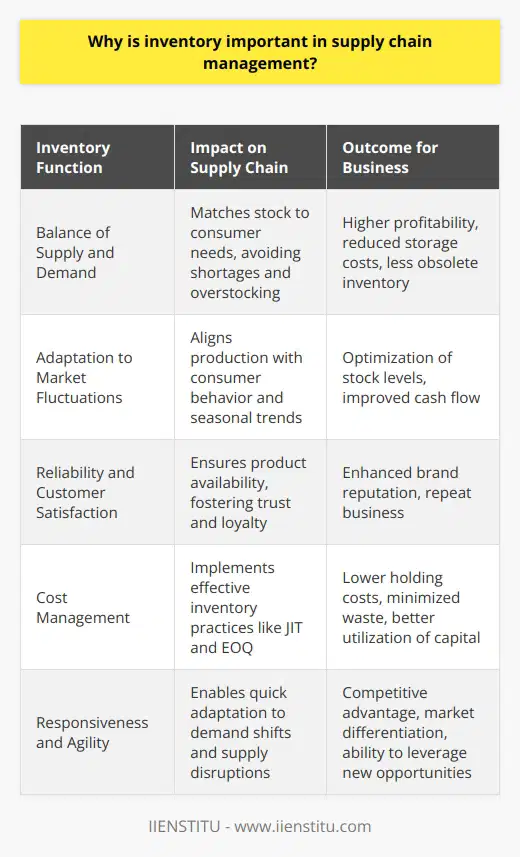
How does inventory affect supply chain performance and efficiency?
Inventory Influence on Performance and Efficiency
Inventory greatly influences supply chain performance and efficiency. High inventory levels can guarantee product availability, contributing to enhanced customer service. However, they can also increase costs tied to storage, handling, and risk of obsolescence, reducing overall profitability.
Inventory Levels and Customer Service
Swift response to market demands maintains customer satisfaction. Readiness to meet unpredictable fluctuations in demand often necessitates high inventory levels. This strategy, while costly, can produce superior customer service, enhancing loyalty and potentially increasing sales.
Inventory Costs and Profitability
Conversely, maintaining high inventory levels incurs substantial costs. Storage and handling require financial resources, impacting profit margins negatively. Moreover, high inventory increase risks of product obsolescence, incurring potential losses and waste.
Inventory Management for Efficiency
Effective inventory management balances these opposing pressures, improving supply chain efficiency. Just-In-Time (JIT) methods for instance, operating with minimal inventory, can enhance efficiency. JIT reduces costs and obsolescence risks while maintaining service levels, provided suppliers are reliable and delivery schedules tightly managed.
Inventory and Supply Chain Performance
Ultimately, inventory profoundly impacts supply chain performance. Both excessive and insufficient inventory levels can impair efficiency, service quality, and profitability. Effective management, through methods like JIT, can optimize inventory levels, improving overall supply chain performance. Consequently, managers need tools and strategies to strike the right balance, maximizing supply chain potential.
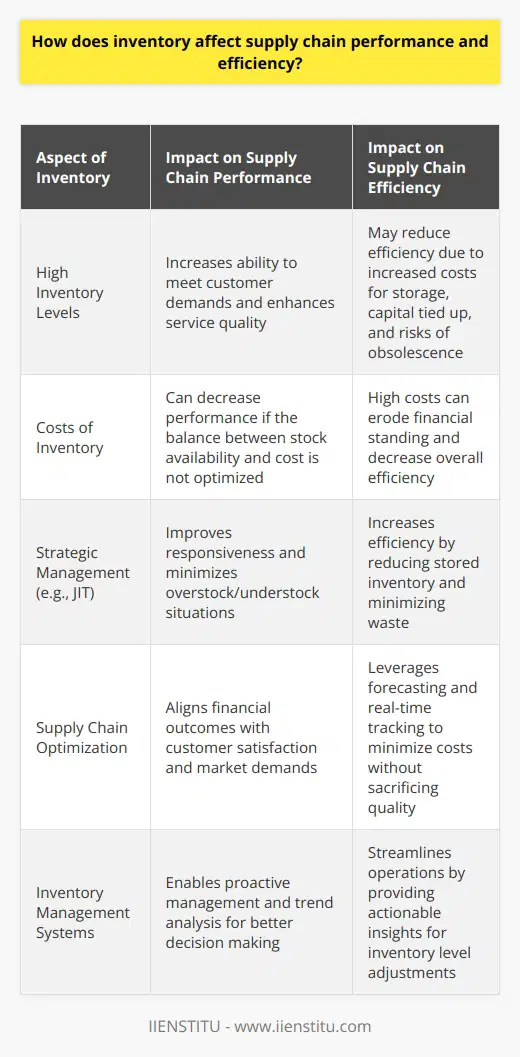
How can good inventory management improve the overall effectiveness and resilience of a supply chain?
Optimizing Inventory Management
Good inventory management can significantly enhance the overall effectiveness and resilience of a supply chain. Firms can facilitate smooth operations by maintaining optimal inventory levels, which ensures the regular flow of goods and mitigates any potential disruptions.
Impact on Overall Efficiency
Effective inventory management reduces the chance of stockouts and overstock situations. Such instances not only affect the company's sales performance but also result in customer dissatisfaction. By striking a perfect balance between supply and demand, companies can fulfill customer requirements consistently and punctually, thereby improving operational efficiency and customer satisfaction.
Revenue and Cost Implications
Cost management, a crucial concern for businesses, can undergo substantial improvements through efficient inventory control. Firms can minimize storage, carrying, and ordering costs, resulting in significant savings. Additionally, proper inventory management eliminates the risk of obsolescence and product wastage, thereby preserving revenues.
Enhancing Supply Chain Resilience
Resilience in a supply chain is about its ability to respond and adapt to disruptions. With good inventory management, firms can ensure continuous supply of goods, even during unforeseen events like supplier delays or abrupt spikes in demand. This resilience to sudden changes or shocks could provide a competitive edge in today's volatile business environment.
In conclusion, effective inventory management is critical in forging a robust and resilient supply chain. It enhances operational efficiency, improves customer satisfaction, saves costs, and boosts overall supply chain resilience. By investing efforts in this direction, businesses can drive real value and maintain a competitive edge.



